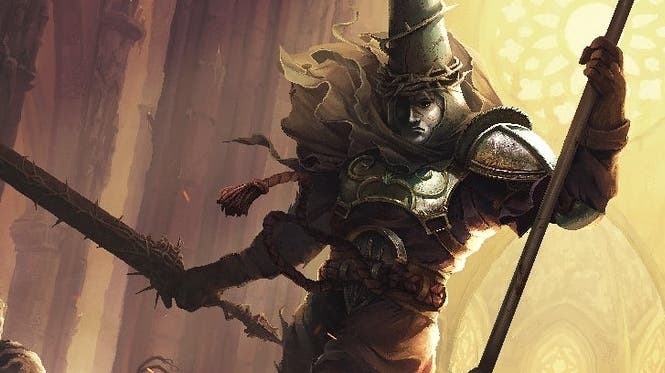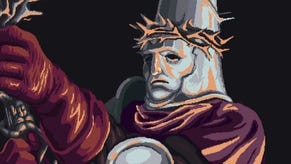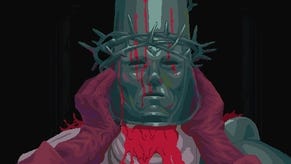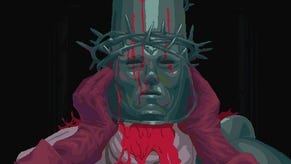Blasphemous review - a grotesque but surprisingly clean take on Souls and Castlevania
Gamepray.
Guilt! Ecstasy! Agony! The corruption and correction of the flesh! Blasphemous is all of these things and m- no, wait. Blasphemous is only these things: all else is heresy, fit to be thrown on the pyre. A gruesome pixelart hybrid of Castlevania and Dark Souls, it casts you as the Penitent One, a musclebound chap in a pointy helmet, who must cleanse a fallen civilisation on behalf of a quasi-Catholic deity known as the Miracle.
You wake up on a charnelpile deep in a crumbling vault, immediately get into an argument with an ogre wielding a candelabra and, well, everything goes downhill from there. Right the way down, that is, to the bottom of a church bell large enough to encompass an entire level, in what feels like a nod to Soul Reaver's Silent Cathedral. Here you'll encounter toxic mist, goblin folk who are annoyingly good at jumping over your swings, and spectral fencers who vanish after every thrust. And then all the way back up, through slippery chasms where both the wind and the statuary are your enemies, to a convent where an undead abbess has been taking lessons from bullet-hell shooters.
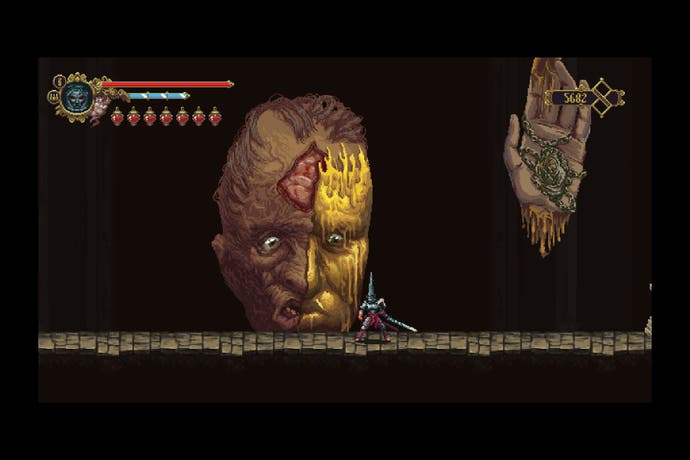
It certainly covers some ground, does Blasphemous, and given a little tolerance for spike pits and irredeemable squalor, there's fun to be had massacring the denizens of this unholy world. Inspired by Francisco Goya's torrid religious paintings and the Gothic monstrosities of the developer's native Seville, Cvstodia is a place of twisted steeples, bloodied gold and the unrelenting spectacle of bodies in pain. The enemies live up to the spaces that contain them, their lavishly animated sprites a mash of bone, chains and sacral cloth. Some can be taken down with combos and evasive slides; others must be parried or jumped over before you can land a blow; still others hang back off-screen, activating terrain traps till vengefully quashed. Full to bursting with wickedness, Cvstodia's inhabitants don't so much die as crescendo, shredding themselves with a screech or erupting into oily flames.
One consequence of the overpowering art direction is that it takes you a while to notice that Blasphemous is a fairly straightforward specimen of its type - even a laidback one, by the standards of the games it takes inspiration from. Much as in Dark Souls, the opening half sees you hunting bosses who reign over different regions, using the energies they guard to open the gate to an endgame area where another gaggle of bigwigs await. There are a few areas that require, or at least strongly encourage, the acquisition of new abilities or gear, but for the most part you can get in everywhere using the basic platforming moves, leaping for ladders and ramming your sword into fissured surfaces to serve as a handhold.
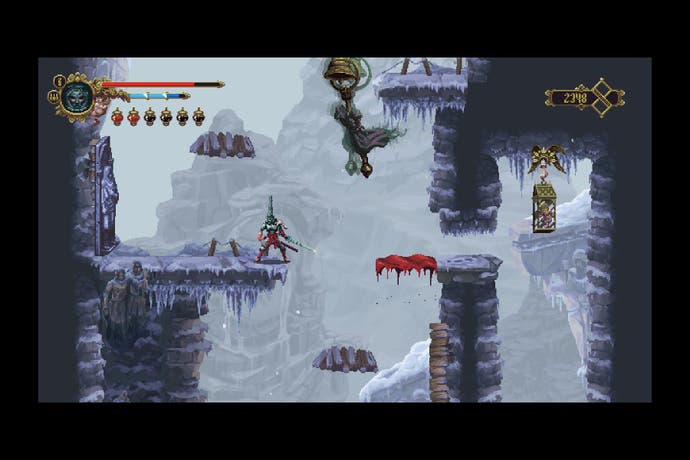
There's a lot of toing and froing, whether between a respawn altar and a boss chamber or between one region and the upgrade facilities at the world's heart. Friendly NPCs also create plenty of optional legwork, badgering you for stray artefacts that are typically found along a different branch of the map. Fail to satisfy their demands before reaching certain milestones and you'll lose them (and the associated reward) forever. The back-and-forth gets wearisome when it comes to levels that are full of collapsing platforms and deadfalls - and yes, garden-variety enemies respawn when you do, though you can often hurry past them. The deeper you delve, however, the easier it is to retrace your steps. You'll find teleportation rooms at the extremities of the landscape, and a rattling elevator shaft through the middle that is unlocked floor by floor. It's an elegantly wrought slice of 'vania, though I'm not sure the layouts quite deliver on the promise of the rucked, sun-stained vistas that yawn behind them.
For all the emphasis on punishment in Blasphemous, it has many ways of letting you off the hook. The frustrations of jumping across those collapsing ledges, for examples, are softened by the fact that most attacks don't knock you out of a leap. The parry timing is generous, and you're invulnerable while the animation is playing out. And then there are the surprisingly manageable drawbacks of mortality. Rather than dropping all your accumulated XP (here known as Tears of Atonement), as in Souls, you'll leave a shivering emblem of guilt at the place of death. This causes thorns to sprout along your Fervor bar, limiting your access to special moves like AOE spells until you track down and expunge these marks of shame.
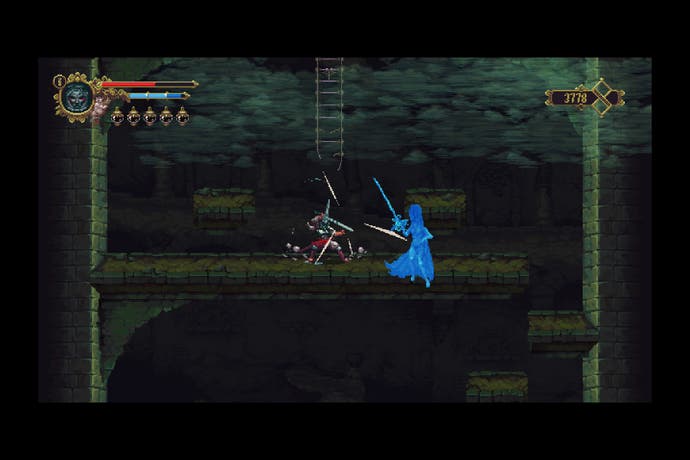
It sounds aggravating, but it takes several deaths before the thorns become an inconvenience, and in any case, you probably won't use special moves that often - they're simply not that effective next to more direct methods of chastising the opposition, such as sliding stabs and groundpounds. Far from hurrying back devoutly to the site of my demise, I found myself depositing little piles of regret everywhere, like an incontinent dog. If scooping up guilt yourself is too much bother (there are Consequences should thorns devour the entire Fervor bar), you can always offer Tears at shrines to wipe the slate clean.
At such times, Blasphemous feels like a game for those who crave the mystique and grotesqueness of Souls, but aren't prepared to pay as dearly in terms of blood and sweat. That feeling dissipates, however, when you run into a boss, all of whom sport fat health reservoirs and attacks that escalate wildly when they're on the ropes. Each boss is as much an assault on the senses as a test of your reflexes. There is a giant, blind-folded baby held aloft by a writhing stack of worms, which strikes by means of a snake-headed tentacle. Elsewhere, a skeletal bishop lounges on a bed of hands, as though crowd-surfing in the wake of an especially rousing sermon. The battles follow age-old patterns - wait for a break in the flow before attacking or healing, memorise which moves can be parried or rolled through and which must be avoided - but within those parameters, there's some decent variety. One encounter sees you climbing a shaft while dodging or deflecting spears. Another, human-sized boss scuttles along the ceiling, throwing and retrieving its blade to conjure a wall of fire.
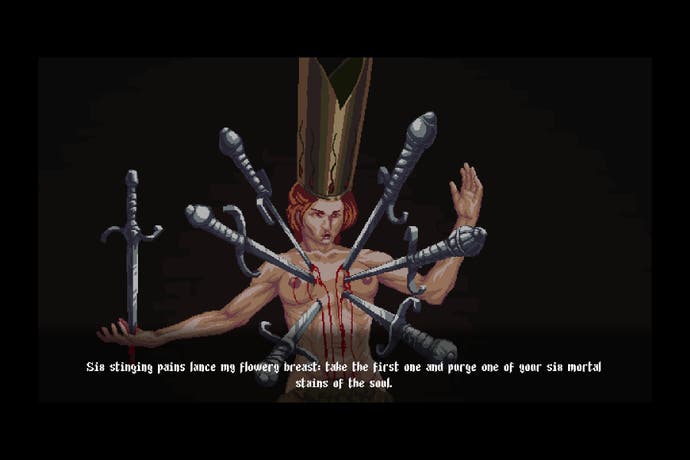
Nonetheless, after 20 hours with it, I still think the best reason to play Blasphemous is the art. The game's raucous personifications of sin and punishment are hardly subtle, but they are always enthusiastic: I don't doubt a scholar of Goya and Catholic ritual would find much to chew over, providing they're dexterous enough to breach the inner sanctums. Set against other descendants of Souls or Castlevania, Blasphemous never stumbles but does fade into the shadow a little. It isn't as fluid and balletic as Sundered, nor as haunting and vertiginous as Hollow Knight, nor as brash and jammed with equipment variables as Dead Cells. Rather than stretching you on the rack, it feels like an old rite faithfully performed.
